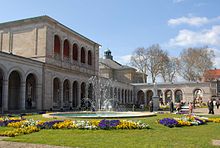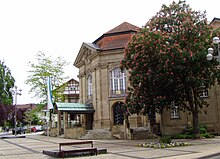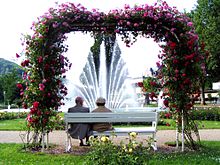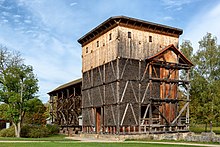| Revision as of 03:40, 4 September 2024 edit184.146.152.17 (talk)No edit summaryTags: Visual edit Mobile edit Mobile web edit← Previous edit | Revision as of 08:16, 4 September 2024 edit undoChiemseehering (talk | contribs)246 editsm historyNext edit → | ||
| Line 49: | Line 49: | ||
| On 10 July 1866, during the ] (campaign at the river ]) of the ], Kissingen was the site of fierce ] between Bavarian and ]n troops, which ended with a Prussian victory.<ref>{{cite book| title=The first | author= Edward Austin Sheldon |publisher= Scribner, Armstrong & company|year= 1875}}</ref> | On 10 July 1866, during the ] (campaign at the river ]) of the ], Kissingen was the site of fierce ] between Bavarian and ]n troops, which ended with a Prussian victory.<ref>{{cite book| title=The first | author= Edward Austin Sheldon |publisher= Scribner, Armstrong & company|year= 1875}}</ref> | ||
| Imperial Chancellor ] visited Bad Kissingen's spas many times. In 1874, during the ''],'' he survived an assassination attempt by the Catholic Eduard Franz Ludwig Kullmann. In 1877, he |
Imperial Chancellor ] visited Bad Kissingen's spas many times. In 1874, during the ''],'' he survived an assassination attempt in the town by the Catholic Eduard Franz Ludwig Kullmann. In 1877, he dictated the ] (German: ''Kissinger Diktat''), in which he explained the principles of his foreign policy. Bismarck's former home in Bad Kissingen is now the Bismarck Museum. | ||
| In June 1911 ], German Secretary of State, and the French ambassador ] had negotiations in Bad Kissingen about Morocco without achieving a solution. The failure of the negotiations led to the ].<ref>{{Cite web |url=http://www.yamaguchy.com/library/fay/origin_104.html|title = Sidney Fay, the Origins of the World War, Vol 1, ch 4}}</ref> | In June 1911 ], German Secretary of State, and the French ambassador ] had negotiations in Bad Kissingen about Morocco without achieving a solution. The failure of the negotiations led to the ].<ref>{{Cite web |url=http://www.yamaguchy.com/library/fay/origin_104.html|title = Sidney Fay, the Origins of the World War, Vol 1, ch 4}}</ref> | ||
Revision as of 08:16, 4 September 2024
For the district, see Bad Kissingen (district).Town in Bavaria, Germany
| Bad Kissingen | |
|---|---|
| Town | |
 Bad Kissingen viewed from Bodenlaube ruins Bad Kissingen viewed from Bodenlaube ruins | |
 Coat of arms Coat of arms | |
Location of Bad Kissingen within Bad Kissingen district
 | |
  | |
| Coordinates: 50°12′N 10°4′E / 50.200°N 10.067°E / 50.200; 10.067 | |
| Country | Germany |
| State | Bavaria |
| Admin. region | Unterfranken |
| District | Bad Kissingen |
| Subdivisions | 9 Stadtteile |
| Government | |
| • Lord mayor (2020–26) | Dirk Vogel (SPD) |
| Area | |
| • Total | 69.42 km (26.80 sq mi) |
| Elevation | 220 m (720 ft) |
| Population | |
| • Total | 23,245 |
| • Density | 330/km (870/sq mi) |
| Time zone | UTC+01:00 (CET) |
| • Summer (DST) | UTC+02:00 (CEST) |
| Postal codes | 97688 |
| Dialling codes | 0971 |
| Vehicle registration | KG |
| Website | www.badkissingen.de |
| UNESCO World Heritage Site | |
| UNESCO World Heritage Site | |
| Part of | The Great Spa Towns of Europe |
| Criteria | Cultural: (ii)(iii) |
| Reference | 1613 |
| Inscription | 2021 (44th Session) |







Bad Kissingen is a German spa town in the Bavarian region of Lower Franconia and seat of the district Bad Kissingen. Situated to the south of the Rhön Mountains on the Franconian Saale river, it is one of the health resorts, which became famous as a "Weltbad" in the 19th century.
In 2021 the town became part of the transnational UNESCO World Heritage Site under the name "Great Spa Towns of Europe", because of its famous mineral springs and its architecture exemplifying the popularity of spa resorts in Europe during the 18th through 20th centuries.
History
The town was first documented in the year 801 under the name chizzicha and was renowned above all for its mineral springs, which are recorded from as early as 823. At that time, Kissingen was under the domination of Fulda Abbey, later it fell to the Counts of Henneberg and was sold to the bishops of Würzburg in the 14th century. Kissingen was first mentioned as "oppidum" (town) in 1279. The town developed into a spa in the 1500s and recorded its first official spa guest in 1520. In 1814, Kissingen became part of Bavaria. The town grew to be a fashionable resort in the 19th century, and was extended during the reign of Ludwig I of Bavaria. Crowned heads of state such as Empress Elisabeth of Austria, Tsar Alexander II of Russia and King Ludwig II of Bavaria, who bestowed the 'Bad' on Kissingen in 1883, were among the guests of the spa at this time. Other well-known visitors to the resort included author Leo Tolstoy, composer Gioachino Rossini and artist Adolph von Menzel.
On 10 July 1866, during the Mainfeldzug (campaign at the river Main) of the Austro-Prussian War, Kissingen was the site of fierce battle between Bavarian and Prussian troops, which ended with a Prussian victory.
Imperial Chancellor Otto von Bismarck visited Bad Kissingen's spas many times. In 1874, during the Kulturkampf, he survived an assassination attempt in the town by the Catholic Eduard Franz Ludwig Kullmann. In 1877, he dictated the Kissingen Dictation (German: Kissinger Diktat), in which he explained the principles of his foreign policy. Bismarck's former home in Bad Kissingen is now the Bismarck Museum.
In June 1911 Alfred von Kiderlen-Waechter, German Secretary of State, and the French ambassador Jules Cambon had negotiations in Bad Kissingen about Morocco without achieving a solution. The failure of the negotiations led to the Agadir Crisis.
The resort's clientele changed in the 20th century, with ordinary people increasingly replacing nobility as guests. The spa suffered a one-year interruption in 1945, the only closure in its history.
Shortly prior to World War II Manteuffel Kaserne (Manteuffel barracks) was established at the eastern edge of the Bad Kissingen town center by the German military as part of Hitler's program to expand the German Wehrmacht. In 1945, the American army entered the town peacefully and took over the Kaserne, which was renamed Daley Barracks in 1953. The barracks were closed in the 1990s after the fall of the Iron Curtain when the American troops were withdrawn.
After the war, the Department of Social Security built clinics in the town. A change in health legislation in the 1990s reduced the opportunities for German health insurance contracts to fund spa visits, which led to job losses. As a result, efforts were made to attract a new kind of clientele, helped in no small part by the EMNID survey which named Bad Kissingen Germany's best-known spa town.
In 2015, about 1.5 million overnight stays of more than 238,000 visitors were registered in the town. With the opening of the KissSalis Therme in February 2004, Bad Kissingen gained a spa leisure centre and, in December 2004, the German-Chinese Football Academy was opened in the town, where the Chinese "08 Star Team" lived and trained in preparation for the Olympic Games in Beijing in 2008.
-
 Kissingen about 1850, still with remains of the medieval fortification
Kissingen about 1850, still with remains of the medieval fortification
-
 The Battle of Kissingen, 10 July 1866
The Battle of Kissingen, 10 July 1866
-
 Tsar Alexander II of Russia (centre, with hat in his hand) and king Ludwig II of Bavaria in 1868
Tsar Alexander II of Russia (centre, with hat in his hand) and king Ludwig II of Bavaria in 1868
-
 Eduard Kullmann (right) shoots at Otto von Bismarck in 1874
Eduard Kullmann (right) shoots at Otto von Bismarck in 1874
-
 Bad Kissingen with its new station (left), about 1875
Bad Kissingen with its new station (left), about 1875
Spa town
There are 7 mineral springs in Bad Kissingen, all of which are still used today. All but the Schönborn spring are cold, containing high levels of sodium, carbonates, and sulphates. The springs are located in the Kissingen-Haßfurt fault zone, absorbing minerals from Permian-era sediment layers.
Bad Kissingen was one of the leading spas in the 19th and early 20th century, which in German are called "Weltbad". They differ from other spa resorts mainly through the following criteria:
- Entertainment: The social life in a "Weltbad" is at least as important as the medical cure, or even more. A "Weltbad" offered many opportunities for the spa guests to spend their free time, such as exercise and sports, trips to the surroundings, theater and concert, library and games.
- Guests: The "Weltbad" was attractive to guests from all five continents. Particular attention was paid to prominent visitors, who attracted more visitors, especially from nobility and upscale middle class.
- Architecture: There are spa quarter, quarters with villas, areas for business and care, gardens and parks with a smooth transition into the surrounding landscape
- Infrastructure and supply: Despite the small number of inhabitants, a "Weltbad" offered the guests all the contemporary comfort, which was not even common in all major cities. These include good transport connections, communication facilities (such as telegraphy and telephone on the latest state of the art), luxury goods offer, differentiated hotel and gastronomy as well as state-of-the-art technology for energy supply, water supply and sanitation.
Geography
Subdivision
In addition to the main town of Bad Kissingen, its districts include (with population numbers given in brackets, as of 1 January 2011):
- Albertshausen (624)
- Arnshausen (1,244)
- Bad Kissingen (11,003)
- Garitz (4,557)
- Hausen (1,704)
- Kleinbrach (375)
- Poppenroth (876)
- Reiterswiesen (2,103)
- Winkels (1,378)
Climate
| Climate data for Bad Kissingen (1991–2020 normals) | |||||||||||||
|---|---|---|---|---|---|---|---|---|---|---|---|---|---|
| Month | Jan | Feb | Mar | Apr | May | Jun | Jul | Aug | Sep | Oct | Nov | Dec | Year |
| Mean daily maximum °C (°F) | 3.3 (37.9) |
5.0 (41.0) |
9.9 (49.8) |
15.3 (59.5) |
19.4 (66.9) |
22.7 (72.9) |
25.0 (77.0) |
24.7 (76.5) |
19.7 (67.5) |
13.6 (56.5) |
7.3 (45.1) |
3.8 (38.8) |
14.1 (57.4) |
| Daily mean °C (°F) | 0.7 (33.3) |
1.5 (34.7) |
5.1 (41.2) |
9.5 (49.1) |
13.5 (56.3) |
16.8 (62.2) |
18.7 (65.7) |
18.2 (64.8) |
13.8 (56.8) |
9.1 (48.4) |
4.5 (40.1) |
1.5 (34.7) |
9.4 (48.9) |
| Mean daily minimum °C (°F) | −1.9 (28.6) |
−1.8 (28.8) |
0.8 (33.4) |
3.9 (39.0) |
7.7 (45.9) |
11.0 (51.8) |
12.9 (55.2) |
12.5 (54.5) |
8.9 (48.0) |
5.4 (41.7) |
2.0 (35.6) |
−0.8 (30.6) |
5.1 (41.2) |
| Average precipitation mm (inches) | 59.5 (2.34) |
45.0 (1.77) |
45.1 (1.78) |
34.2 (1.35) |
60.6 (2.39) |
58.7 (2.31) |
76.6 (3.02) |
59.2 (2.33) |
49.3 (1.94) |
53.3 (2.10) |
56.9 (2.24) |
68.7 (2.70) |
665.8 (26.21) |
| Average precipitation days (≥ 1.0 mm) | 16.4 | 13.8 | 14.1 | 11.9 | 13.4 | 14.0 | 14.5 | 13.5 | 12.1 | 15.3 | 16.5 | 18.1 | 173.1 |
| Average snowy days (≥ 1.0 cm) | 9.8 | 6.7 | 2.3 | 0.1 | 0 | 0 | 0 | 0 | 0 | 0 | 1.3 | 5.2 | 25.4 |
| Average relative humidity (%) | 85.4 | 81.3 | 75.0 | 67.8 | 70.7 | 70.9 | 70.8 | 72.2 | 78.6 | 85.7 | 88.9 | 88.5 | 78.0 |
| Mean monthly sunshine hours | 42.0 | 70.7 | 121.4 | 176.8 | 204.2 | 217.2 | 226.5 | 209.2 | 148.9 | 92.2 | 39.6 | 28.6 | 1,590.8 |
| Source: World Meteorological Organization | |||||||||||||
Governance
Mayors
- Franz Meinow (1910–1947): 1945–1946
- Franz Rothmund (1873–1954): 1946–1947
- Karl Fuchs (1881–1972): 1947–1952
- Hans Weiß (1919–2008): 1952–1984
- Georg Straus (1926–2014): 1984–1990
- Christian Zoll (1941–2017): 1990–2002
- Karl Heinz Laudenbach (born 1957): 2002–2008
- Kay Blankenburg (born 1957): 2008–2020
- Dirk Vogel (born 1977): since 2020
Town Council
The Council of Bad Kissingen (2020–2026), elected on 15 March 2020:
- The mayor Dirk Vogel (Social Democratic Party of Germany, SPD)
- 9 members of the Christian Social Union of Bavaria (CSU)
- 6 members of the (SPD)
- 4 members of the Demokratische Bürger Kissingen (DBK, local group)
- 3 members of the Freie Wähler party, (Free voters)
- 4 members of the Bürger für Umwelt (BfU) /Alliance 90/The Greens /ödp
- 2 members of the Alternative for Germany (AfD)
- 1 member of the Left Party
- 1 member of the Zukunft Bad Kissingen (local group)
In May 2020, three members of the CSU changed to DBK. Since then, the CSU has had 6 members in the town council, the DBK seven.
Twin towns
Bad Kissingen is twinned with:
 Eisenstadt, Austria (1978)
Eisenstadt, Austria (1978) Massa, Italy (1960)
Massa, Italy (1960) Vernon, France (1960)
Vernon, France (1960)
Arts and culture
Museums
- Bismarck-Museum in the Obere Saline (upper saltworks)
- Permanent exhibition: Jewish life in the former Jewish school
- Cardinal-Döpfner-Museum in Hausen
Music
- The classical music festival Kissinger Sommer with participation of internationally well known orchestras and soloists is a highlight of the cultural calendar.
- Kissinger Piano Olympics (Klavierolymp), a competition of young pianistes, related to the Kissinger Sommer, is held in autumn.
- Another music festival called the Kissinger Winterzauber takes place each winter.
- The national German brass band contest has been hosted in Bad Kissingen in 2014 and 2016.
Architecture
The Botenlauben Castle Ruins from 1180 overlooks Bad Kissingen from above. The old town hall is a renaissance architecture design from 1577. The town hall of today is the former mansion of the noble family von Heußlein, built by Johann Dientzenhofer in 1706.
Between 1838 and 1913, the arcade (Arkadenbau) was built around the spa garden by Friedrich von Gärtner, as well as the halls for the use of the mineral water ("Brunnenhalle") and for promenades ("Wandelhalle"), following a design by Max Littmann. Littmann also designed the Kurtheater Bad Kissingen, completed in 1905, and the concert hall Regentenbau, inaugurated in 1913.
The train station building was designed and supervised by Friedrich Bürklein. The Bad Kissingen Train station was constructed between 1871 and 1874.
-
Bismarck-Museum
-
"Wandelhalle" in the spa area
-
 "Brunnenhalle" at the spa garden
"Brunnenhalle" at the spa garden
-
 Old town hall and market square
Old town hall and market square
-
Casino Bad Kissingen
Other architectural attractions in Bad Kissingen include:
- Bismarck Monument (Bad Kissingen)
- Bismarck Tower (Bad Kissingen)
- Ludwig Tower (Bad Kissingen)
- Wittelsbacher Tower (Bad Kissingen)
World Cup 2006
During the World Cup 2006, Bad Kissingen was home to the Ecuador national team (the Croatia team was in Bad Brückenau). Sports facilities and infrastructure were upgraded for the team.
Education
- Berufschule Bad Kissingen vocational school
Notable people

- Jeff Baker (born 1981), MLB infielder on the Miami Marlins
- Otto von Botenlauben (1177–1245), Count of Henneberg, minnesinger and crusader
- Claus-Frenz Claussen (1939–2022), otolaryngologist
- Julius Döpfner (1913–1976), cardinal and archbishop of München and Freising
- Sir Dorabji Tata (1859-1932), a key figure in the history and development of the Tata Group died here
- Trong Hieu (born 1992), Vietnam Idol winner 2015
- Baptist Hoffmann (1863–1937), operatic baritone and voice teacher
- Cyrill Kistler (1848–1907), composer, music educator and music publisher
- Henry Kissinger's (1923–2023) great-great-grandfather, Meyer Löb, derived his name from Bad Kissingen in 1817
- Anton Kliegl (1872–1927), inventor of the Klieg light
- Oskar Panizza (1853–1921), physician and writer
- Hanna Ralph (1888–1978), stage and film actress
- Philipp Schmitt (1902–1950), SS commandant of Nazi prison camp executed for war crimes
- Jack Steinberger (1921–2020), physicist and Nobel Prize winner
See also
References
- "Dirk Vogel wird neuer Oberbürgermeister, Main-Post 15 March 2020 (in German)". Archived from the original on 17 July 2020. Retrieved 17 March 2020.
- Genesis Online-Datenbank des Bayerischen Landesamtes für Statistik Tabelle 12411-003r Fortschreibung des Bevölkerungsstandes: Gemeinden, Stichtag (Einwohnerzahlen auf Grundlage des Zensus 2011).
- "Ein Platz für das Weltbad Bad Kissingen". 24 March 2014.
- Landwehr, Andreas (24 July 2021). "'Great Spas of Europe' awarded UNESCO World Heritage status". Deutsche Presse-Agentur. Archived from the original on 25 July 2021. Retrieved 25 July 2021.
- "The Great Spa Towns of Europe". UNESCO World Heritage Centre. Retrieved 25 July 2021.
- Thomas Ahnert, Peter Weidisch: 1200 Jahre Bad Kissingen, 801–2001, Facetten einer Stadtgeschichte, Bad Kissingen 2001, ISBN 3929278162
- Bad Kissingen, Merkur, 10 March 2021 (in German)
- Edward Austin Sheldon (1875). The first. Scribner, Armstrong & company.
- "Sidney Fay, the Origins of the World War, Vol 1, ch 4".
- "Immer noch bekanntester Kurort". 20 May 2008. Archived from the original on 20 February 2017. Retrieved 19 February 2017.
- "Archived copy" (PDF). Archived from the original (PDF) on 26 February 2017. Retrieved 25 February 2017.
{{cite web}}: CS1 maint: archived copy as title (link) - ^ Nomination of the Great Spas of Europe for inclusion on the World Heritage List (Report). United Nations Educational, Scientific, and Cultural Organization. Retrieved 21 August 2021.
- "Weltbad Kissingen".
- "World Meteorological Organization Climate Normals for 1991–2020". World Meteorological Organization Climatological Standard Normals (1991–2020). National Oceanic and Atmospheric Administration. Archived from the original on 12 October 2023. Retrieved 12 October 2023.
- "Stadtratswahl Bad Kissingen: Grüne verdoppeln ihre Sitze", Saale-Zeitung, 17 March 2020 (in German)
- "Bad Kissingen: Drei Stadträte verlassen CSU-Ratsfraktion" Archived 4 June 2020 at the Wayback Machine, Main Post, 8 May 2020
- "Partnerstädte der Stadt Bad Kissingen" (in German). Bad Kissingen. Archived from the original on 8 December 2021. Retrieved 8 December 2021.
- Andres Lepik; Katrin Bäumler, eds. (2018). The Architecture Under King Ludwig II Palaces and Factories. Walter de Gruyter. p. 195. ISBN 9783035616538.
- Arnold, Michael (18 October 2015). "Zero to Hero". Oi Vietnam. Metro Advertising.;
- "Die Kissingers in Bad Kissingen". Bayerischer Rundfunk (in German). 2 June 2005. Archived from the original on 29 September 2007. Retrieved 3 February 2007.
External links
- Official website (in German)
- Chisholm, Hugh, ed. (1911). "Kissingen" . Encyclopædia Britannica. Vol. 15 (11th ed.). Cambridge University Press.
- The Town That's Building Life Around Sleep
| Towns and municipalities in Bad Kissingen (district) | ||
|---|---|---|
| The Great Spa Towns of Europe | ||
|---|---|---|
| UNESCO World Heritage Site | ||
|  | |
